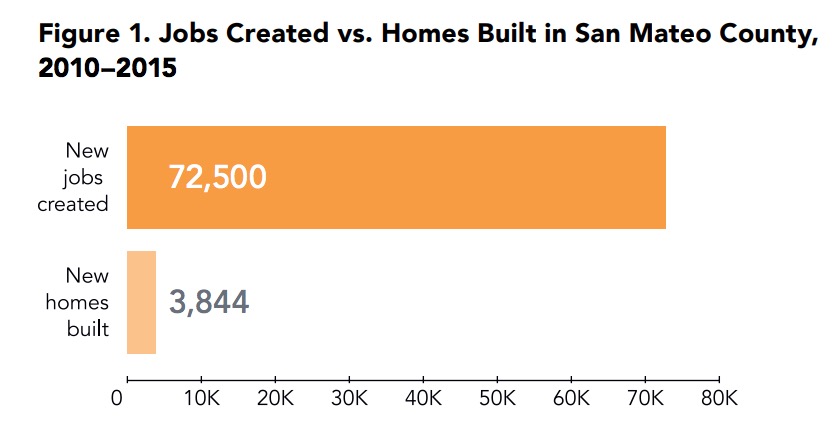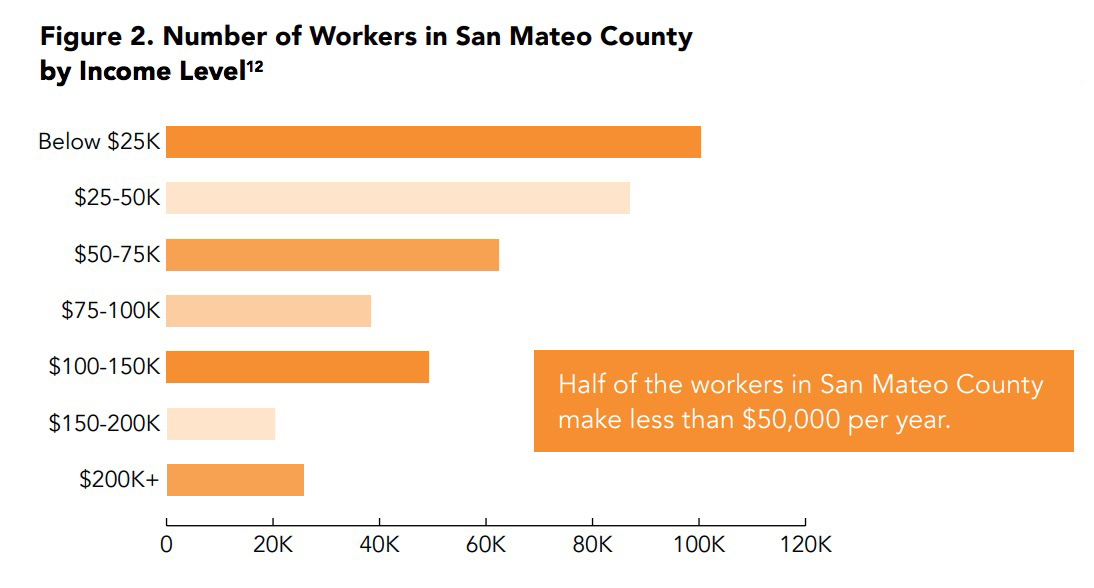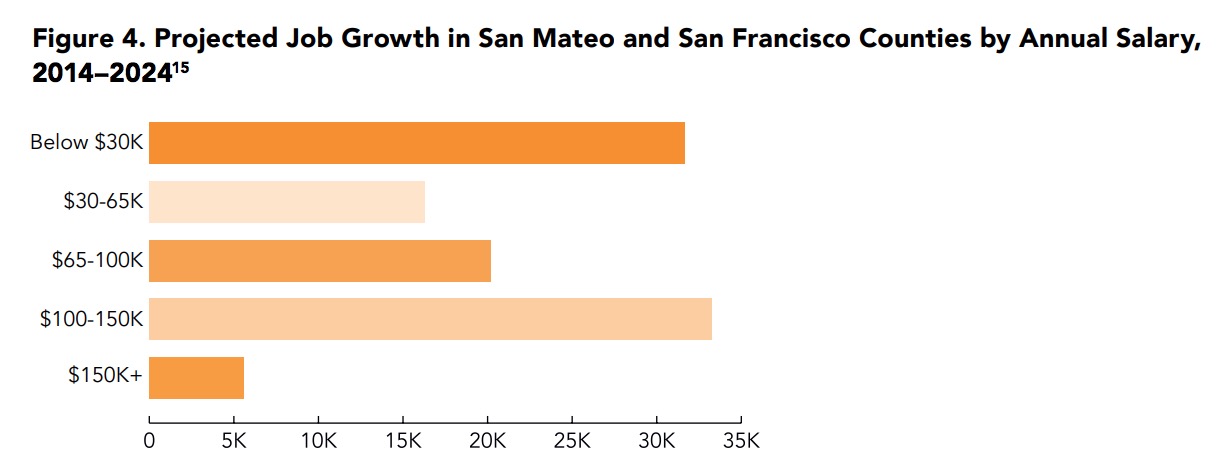TRANSFORM
HOUSING LEADERSHIP COUNCIL
Silicon Valley is booming. The economy has come roaring back since the 2008 downturn. Thousands of new jobs have been created.
In fact, between 2010 and 2017, roughly 80,000 jobs were created in San Mateo County. In 2013, the total surged past even the 1999 high-water mark of the dot-com boom, and there are more total jobs in the county than ever before.
The Economy Races Ahead; Traffic Slows to a Crawl
That roaring economy has an impact everyone feels: more traffic.
According to a 2017 report by the Metropolitan Transportation Commission, the region has set a new record for congestion-related delays, which have gotten 80% longer since 2010. In Silicon Valley specifically, commuters now spend over 37 hours a year sitting in traffic.
The effects add up. Over 37 hours is almost an entire work week (or a week of vacation!) each person is losing each year. That’s less time that commuters have to spend time with their children, care for older parents, reach another job, see friends, stay engaged in their community, or simply rest.
Regionally and locally, increased driving and the resulting traffic are also taking a toll on air quality and the region’s efforts to fight climate change. Much of the air pollution in San Mateo County comes from vehicle traffic: in fact, 58% of the county’s greenhouse gas emissions come from transportation, which emits, as of 2013, 3.2 million tons of carbon per year.
Tackling Traffic
It might seem that the solution to traffic would be to add more road capacity: build or widen roads, and add lanes to highways.
But adding road capacity is extremely expensive, and according to a comprehensive state study, ineffective. For example, when the I-405 in Los Angeles opened in 2014 after five years of construction, at a cost of $1 billion, the traffic actually moved slightly slower than before. A similar phenomenon occurred on Houston’s Katy Freeway, whose widening cost $2.8 billion.
This is because of what economists term “induced demand,” where increasing the supply of something creates new demand for it: building more roads results in more driving. Put another way, “if you build it, they will come.” In 2015, a state-sponsored research review concluded that “Numerous studies … consistently show that adding capacity to roadways fails to alleviate congestion for long because it actually increases vehicle miles traveled.” The review also added, “Most studies show…. No net increase in employment or other [economic] activity” from highway expansion.
Widening roads will not fix the problem and may make matters worse.
San Mateo County needs more integrated solutions. The first approach must be to manage travel demand—that is, reduce the need to travel long distances in the first place. The second is to provide more and better transportation options, especially for those who need them most.
Reducing travel demand requires looking at what is causing the traffic: one of the most important factors is the scarcity of homes local workers can afford, that are close to jobs and high-quality public transit.
Failing to Build Enough Homes
 As thousands of jobs are being created every year, more and more people are working in San Mateo County, and they need places to live. However, the planning for new homes is falling far short. Between 2010 and 2016, 80,000 new jobs were created, but permits were only issued for 8,000 new homes. That’s one home approved for every 10 jobs created.
As thousands of jobs are being created every year, more and more people are working in San Mateo County, and they need places to live. However, the planning for new homes is falling far short. Between 2010 and 2016, 80,000 new jobs were created, but permits were only issued for 8,000 new homes. That’s one home approved for every 10 jobs created.
The actual building is even more inadequate. Between 2010 and 2015, 72,800 new jobs were created, and just 3,844 new homes were built (Figure 1). That’s one home built for every 19 jobs created.
Far too few homes are being built. With each year that passes, we are digging ourselves into a bigger hole, forcing more and more workers to commute long distances.
And the problem is even more acute than these numbers indicate. While it is difficult for those with high salaries to find decent housing, it becomes almost impossible for lower-income workers. The result is that the greatest burden falls on those with the fewest resources: those who make the least have to travel the most, to jobs that are the least likely to be flexible.
Earning Less, Driving More
When people think about Silicon Valley, many people might assume that most of San Mateo County’s thousands of new jobs are high-paying positions in the technology sector.
 But many of the jobs in San Mateo County are in sectors like service and retail, and many of these jobs pay low wages. Throughout Silicon Valley, jobs at every wage level have increased, but middle-tier jobs—which historically have made up the majority of employment—now make up a smaller proportion of the whole. This is contributing to widening economic inequality.
But many of the jobs in San Mateo County are in sectors like service and retail, and many of these jobs pay low wages. Throughout Silicon Valley, jobs at every wage level have increased, but middle-tier jobs—which historically have made up the majority of employment—now make up a smaller proportion of the whole. This is contributing to widening economic inequality.
Over 100,000 workers in San Mateo County make less than $25,000 a year (Figure 2). The total number of workers making less than $50,000 a year is 187,000, 49% of all the workers in the county.
Today, workers who make less than $50,000 make up 40% of the people commuting in from outside San Mateo County (Figure 3). That’s because many cannot find homes they can afford here.
San Mateo County is projected to continue to add many more jobs. Many of those jobs will continue to pay low wages.
 State projections for job growth in San Mateo County (which also include San Francisco County) anticipate that about 48,000 of the jobs that will be added by 2024, or 45%, will be in the bottom two income brackets (Figure 4).
State projections for job growth in San Mateo County (which also include San Francisco County) anticipate that about 48,000 of the jobs that will be added by 2024, or 45%, will be in the bottom two income brackets (Figure 4).
Even in this booming economy, almost half of new jobs are projected to pay less than $65,000 per year. And the people who do these jobs with these wages will need places to live.
Download full version (PDF): Moving San Mateo County Forward
About TransForm
www.transformca.org
TransForm promotes walkable communities with excellent transportation choices to connect people of all incomes to opportunity, keep California affordable and help solve our climate crisis.
About the Housing Leadership Council
hlcsmc.org
HLC was founded to build a network of people who support the development of new housing (particularly affordable housing), to build community support for housing, and to advocate for policies that address the root causes of the housing shortage.
Tags: CA, California, Housing, San Mateo County, Silicon Valley, TRANSFORM, Transit






 RSS Feed
RSS Feed